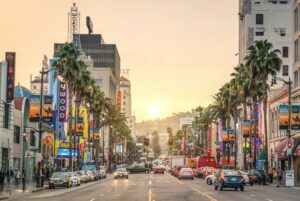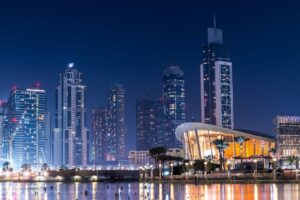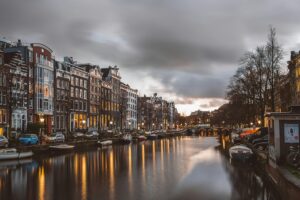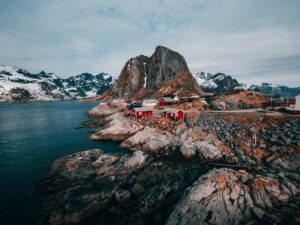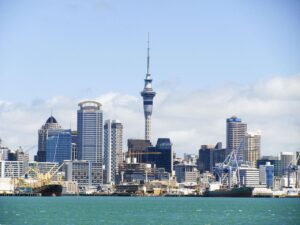Vietnam has emerged as one of Southeast Asia’s most captivating destinations, drawing over 12.6 million international visitors in 2023 according to the Vietnam National Administration of Tourism. This slender S-shaped nation stretches over 1,650 kilometers from north to south, offering an extraordinary blend of ancient culture, colonial heritage, modern cities, and some of the world’s most breathtaking natural landscapes.
From the misty mountains of Sapa to the bustling streets of Ho Chi Minh City, Vietnam presents a tapestry of experiences that cater to every type of traveler. Whether you’re seeking spiritual enlightenment at ancient temples, culinary adventures through street food markets, or adrenaline-pumping activities in pristine nature, Vietnam delivers in abundance.
So, what are the top 10 places to visit in Vietnam? This comprehensive guide answers that question by taking you on a journey through the country’s most iconic destinations. We’ll explore the timeless capital of Hanoi, the UNESCO-listed wonders of Ha Long Bay and Hoi An, the imperial grandeur of Hue, and the coastal beauty that stretches from Da Nang to Nha Trang.
This article is designed for both first-time visitors planning their inaugural Vietnamese adventure and returning travelers seeking to deepen their understanding of this magnificent country. Each destination offers its own unique character, contributing to Vietnam’s reputation as one of the world’s fastest-growing tourism markets.
TL;DR: Top 10 places to visit in Vietnam
Here’s your snapshot of Vietnam’s top 10 must-visit destinations:
- Hanoi – Timeless capital of culture and legendary street food
- Ha Long Bay – Iconic limestone karsts and island cruises
- Sapa – Terraced rice fields and ethnic hill tribes
- Ninh Binh – “Ha Long Bay on land” with ancient temples
- Hue – Imperial city of history and architecture
- Da Nang – Coastal hub blending beaches and mountains
- Hoi An – Lantern-lit old town and heritage charm
- Nha Trang – Vibrant beach city with island adventures
- Da Lat – Highland retreat of waterfalls and flowers
- Ho Chi Minh City – Energetic metropolis of modern Vietnam
1. Hanoi
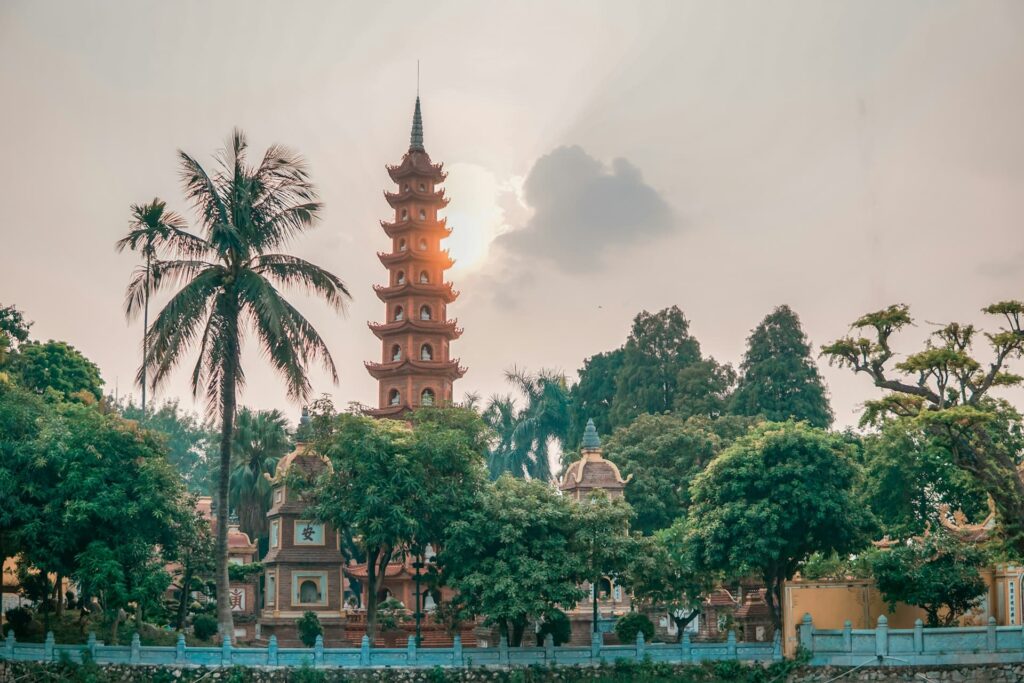
Hanoi, Vietnam’s capital for over a millennium, is where ancient traditions meet contemporary energy. This city of 8 million people pulses with life, from the chaotic charm of its Old Quarter to the serene waters of Hoan Kiem Lake.
Highlights
The Old Quarter (Pho Co) represents Hanoi’s beating heart. Its 36 ancient streets—each historically dedicated to a specific trade—now overflow with street food vendors, silk shops, and colonial-era architecture. The Hoan Kiem Lake provides an oasis of calm where locals practice tai chi at dawn.
The Temple of Literature (Van Mieu), built in 1070, served as Vietnam’s first national university and remains one of the country’s finest examples of traditional Vietnamese architecture. The complex honors Confucian scholars and showcases the country’s deep reverence for education.
Don’t miss the Ho Chi Minh Mausoleum Complex, a pilgrimage site for many Vietnamese, or the atmospheric Water Puppet Theatre, a uniquely northern Vietnamese art form dating back to the 11th century.
Why Visit
Hanoi serves as the cultural and political capital of Vietnam, offering unparalleled insights into Vietnamese identity. The city’s café culture is legendary—Hanoi claims to have originated the famous Vietnamese egg coffee (ca phe trung). For food enthusiasts, Hanoi’s street food scene ranks among Asia’s best, with Anthony Bourdain famously declaring his love for the city’s bun cha.
As the gateway to northern Vietnam, Hanoi provides convenient access to Ha Long Bay, Sapa, and Ninh Binh, making it an essential starting point for any Vietnamese adventure.
Best Time to Visit
October through April offers the most pleasant weather, with cooler temperatures ranging from 15-25°C (59-77°F). The period from November to February can be surprisingly chilly, so pack layers.
Summer months (May-September) bring heat and humidity, with temperatures soaring to 38°C (100°F) and occasional heavy rains.
How to Get There
Noi Bai International Airport (HAN), located 35 kilometers north of the city center, connects Hanoi to major Asian hubs and select international destinations. The airport served over 27 million passengers in 2023.
Transportation options include:
- Airport bus: Route 86 (affordable at ~45,000 VND)
- Taxi: ~350,000-450,000 VND (~$15-20 USD)
- Grab (Southeast Asia’s Uber): Convenient and metered
Hanoi also serves as a major railway hub, with overnight trains connecting to southern destinations like Hue, Da Nang, and Ho Chi Minh City.
Pro tip: Book your Vietnam travel experiences in advance during peak season (December-February) to secure the best rates.
2. Ha Long Bay
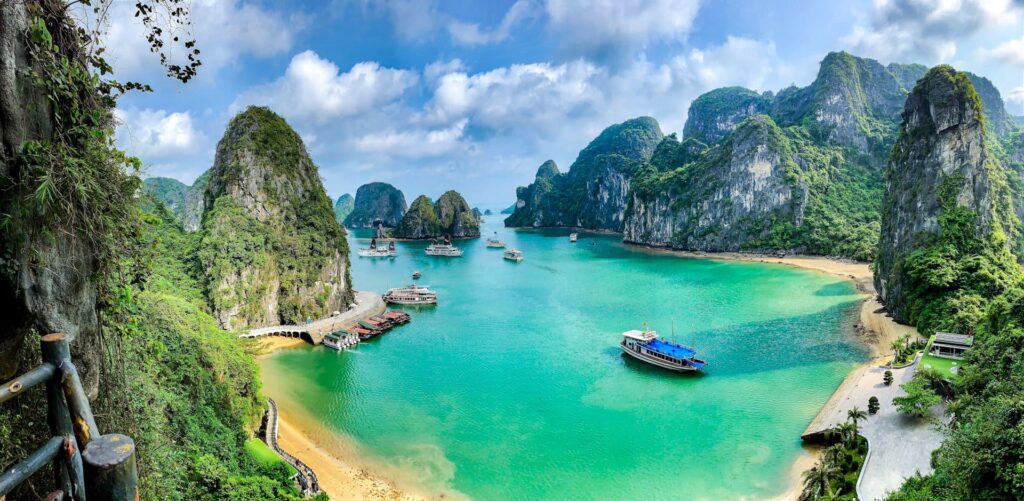
Ha Long Bay (Vinh Ha Long, meaning “descending dragon bay”) stands as Vietnam’s most iconic natural landmark. This UNESCO World Heritage Site, designated in 1994, encompasses approximately 1,600 limestone karsts and islets rising dramatically from emerald waters across 1,553 square kilometers.
Highlights
A cruise experience remains the quintessential way to explore Ha Long Bay. Options range from budget day trips to luxury overnight cruises aboard traditional wooden junks. Most itineraries include:
The Sung Sot Cave (Surprise Cave), one of the bay’s largest and most spectacular grottoes, features otherworldly stalactites and stalagmites formations. Ti Top Island offers a challenging climb rewarded with panoramic bay views.
Kayaking through hidden lagoons and grottos provides intimate encounters with the bay’s geology. Many cruises also include cooking classes, tai chi sessions at sunrise, and visits to floating fishing villages.
For adventure seekers, Cat Ba Island—the bay’s largest island—offers rock climbing, hiking in Cat Ba National Park, and encounters with the critically endangered Cat Ba langur, one of the world’s rarest primates.
Why Visit
Ha Long Bay represents nature’s architecture at its finest. The bay’s karst formations, created over 500 million years of geological evolution, create a surreal seascape that has inspired countless artists and photographers.
Beyond its visual splendor, Ha Long Bay holds deep cultural significance in Vietnamese mythology. Legend tells of dragons sent by gods to defend Vietnam against invaders—the islands are said to be emeralds scattered by these dragons.
The bay’s ecosystem supports incredible biodiversity, with over 200 fish species, 450 species of mollusks, and numerous coral reefs, making it a priority destination for marine conservation efforts.
Best Time to Visit
March through June and September through November offer optimal conditions. March to May brings mild temperatures (20-25°C) with minimal rain, while September to November provides clear skies and calm seas.
Avoid July and August when typhoons are most likely, and December through February when heavy fog can obscure views and cold temperatures (10-15°C) make cruising less comfortable.
How to Get There
Ha Long Bay lies approximately 165 kilometers (103 miles) east of Hanoi, requiring a 2.5-3 hour drive. Transportation options include:
- Private car or minibus: Most convenient, bookable through hotels (~$50-80 for round-trip)
- Public bus: From My Dinh or Luong Yen bus stations in Hanoi (~100,000 VND)
- Seaplane: For luxury travelers, Hai Au Aviation operates scenic flights
Most travelers book all-inclusive cruise packages from Hanoi that include transportation, making logistics effortless.
3. Sapa
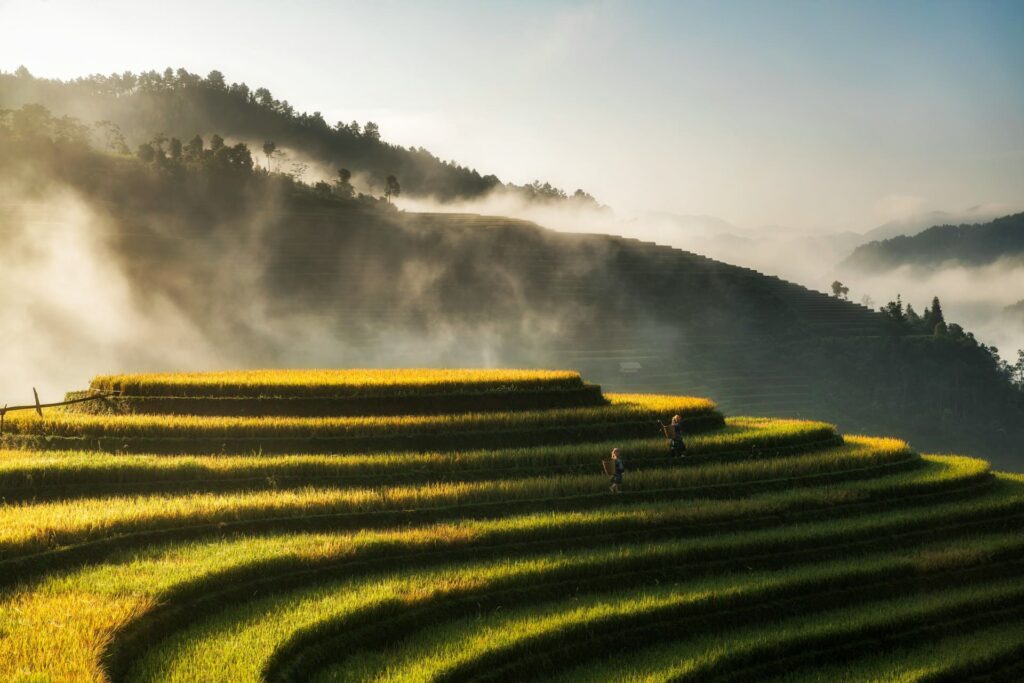
Perched at 1,600 meters (5,249 feet) above sea level in Vietnam’s northwestern highlands, Sapa offers a dramatic departure from the country’s tropical lowlands. This former French hill station has evolved into Vietnam’s premier trekking destination, famous for its terraced rice fields and encounters with ethnic minority communities.
Highlights
Fansipan Peak, nicknamed the “Roof of Indochina,” towers at 3,143 meters (10,312 feet). While serious trekkers can attempt the challenging 2-3 day climb, a modern cable car system now whisks visitors to near the summit in 15 minutes, offering breathtaking panoramic views.
Cat Cat Village, home to the Black H’mong people, sits just 2 kilometers from Sapa town. This living museum showcases traditional textile weaving, silver smithing, and sustainable tourism practices. The nearby Muong Hoa Valley contains hundreds of ancient rock carvings dating back 3,000 years.
The terraced rice fields create a living canvas that changes with seasons—bright green during the growing season (May-June), golden yellow at harvest time (September-October), and filled with water creating mirror-like reflections (February-March).
Lao Chai and Ta Van villages offer homestay experiences with Hmong and Dzay families, providing authentic cultural immersion and supporting local communities directly.
Why Visit
Sapa offers Vietnam’s most spectacular mountain scenery and represents one of Southeast Asia’s premier cultural tourism destinations. The region is home to five main ethnic groups—H’mong, Dzao, Tay, Giay, and Xa Pho—each maintaining distinct languages, traditional dress, and customs.
The town itself blends French colonial architecture with local markets where hill tribe women in vibrant traditional dress sell handicrafts and fresh produce. According to tourism statistics, Sapa welcomes over 3 million visitors annually, contributing significantly to poverty reduction in this formerly isolated region.
Best Time to Visit
March through May brings wildflowers and pleasant temperatures (15-20°C). September through November showcases golden rice terraces and clear mountain air—this is peak season, so expect crowds and higher prices.
June through August means rain, leeches on trekking trails, and obscured views, though waterfalls are at their most spectacular. December through February can be bitterly cold (often near 0°C) with occasional snow on Fansipan, but offers a unique experience for those prepared with warm clothing.
How to Get There
Sapa lies 350 kilometers northwest of Hanoi, accessible via:
- Overnight train: The most popular option, departing Hanoi around 9-10 PM and arriving in Lao Cai (35km from Sapa) by 5-6 AM. New luxury trains like the Livitrans Express offer comfortable sleeper cabins (~$50-70).
- Bus: Numerous companies operate sleeper buses (6-7 hours, ~$15-20)
- Private car: Most flexible but expensive (~$150-200)
From Lao Cai station, shuttle buses and taxis complete the journey to Sapa town.
Insider tip: Book accommodations in advance find the best homestays and hotels in Sapa’s beautiful but challenging terrain.
4. Ninh Binh
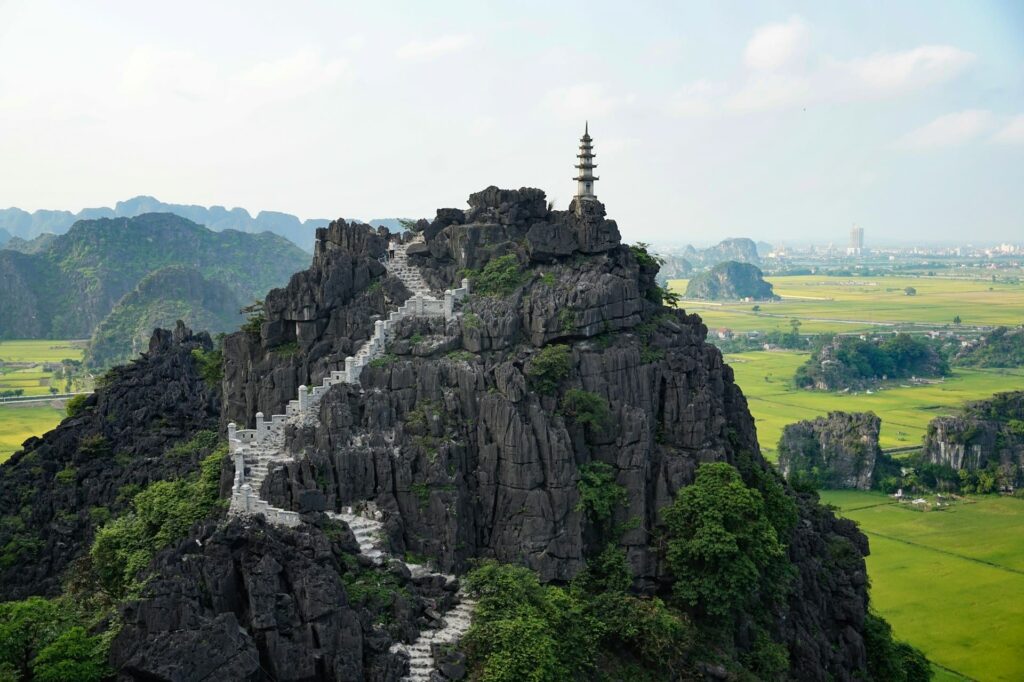
Often called “Ha Long Bay on land,” Ninh Binh province lies just 100 kilometers south of Hanoi, offering spectacular karst landscapes without the cruise boat crowds. This UNESCO World Heritage area combines natural beauty with ancient temples and historical significance, making it an essential stop on any Vietnamese itinerary.
Highlights
Trang An Grottoes, a UNESCO World Heritage site since 2014, encompasses a spectacular boat journey through a complex network of caves, grottoes, and emerald waterways surrounded by towering limestone cliffs. The 2-3 hour sampan ride passes through multiple caves—some so low you must duck—while local rowers (often women) expertly navigate the narrow passages.
Tam Coc (Three Caves), often called the more scenic alternative to Trang An, offers a similar boat experience but in a more intimate setting. The journey through rice paddies and three natural caves takes about 2 hours, with the landscape dubbed “Ha Long Bay in the rice fields.”
The Bai Dinh Pagoda Complex, one of Southeast Asia’s largest Buddhist temples, sprawls across 700 hectares. Its impressive bronze Buddha statue (100 tons, 10 meters high) and 500 La Han statues make it a significant pilgrimage site. An electric cart service helps navigate the vast complex.
Hoa Lu Ancient Capital, Vietnam’s political center in the 10th-11th centuries, preserves temples dedicated to the Dinh and Le dynasties amidst a dramatic karst landscape.
Don’t miss Mua Cave (Dancing Cave)—climb 500 steps to a panoramic viewpoint offering one of Vietnam’s most photographed vistas: a sweeping view of Tam Coc’s karst formations and rice fields.
Why Visit
Ninh Binh provides Ha Long Bay’s limestone drama without the tourist density, making it ideal for travelers seeking authentic, peaceful experiences. According to local tourism data, the province targets 5 million visitors in 2024, yet it feels far less commercialized than its famous coastal counterpart.
The area played a crucial role in Vietnamese history as the country’s capital during the Dinh, Early Le, and Ly dynasties. Its strategic location amid natural fortifications made it the ideal defensive position against Chinese invasions.
Ninh Binh also serves as the gateway to Cuc Phuong National Park, Vietnam’s oldest national park (established 1962), protecting over 2,000 plant species and 300 bird species in pristine primary rainforest.
Best Time to Visit
February through May and September through October offer ideal conditions. Late May to June showcases rice fields at their greenest, while September-October brings golden harvest hues.
Avoid July-August’s intense heat (35-38°C) and heavy rainfall. Winter months (December-February) can be cool and misty, creating atmospheric but sometimes limited visibility.
How to Get There
From Hanoi, Ninh Binh is easily accessible:
- Train: Frequent departures from Hanoi’s main station to Ninh Binh station (2 hours, ~$5-10)
- Bus: From My Dinh or Giap Bat stations (2.5 hours, ~$3-5)
- Private car/day tour: Most convenient for time-limited travelers (~$60-100)
Many travelers combine Ninh Binh with Ha Long Bay in a multi-day tour, maximizing their exploration of Vietnam’s karst landscapes.
5. Hue
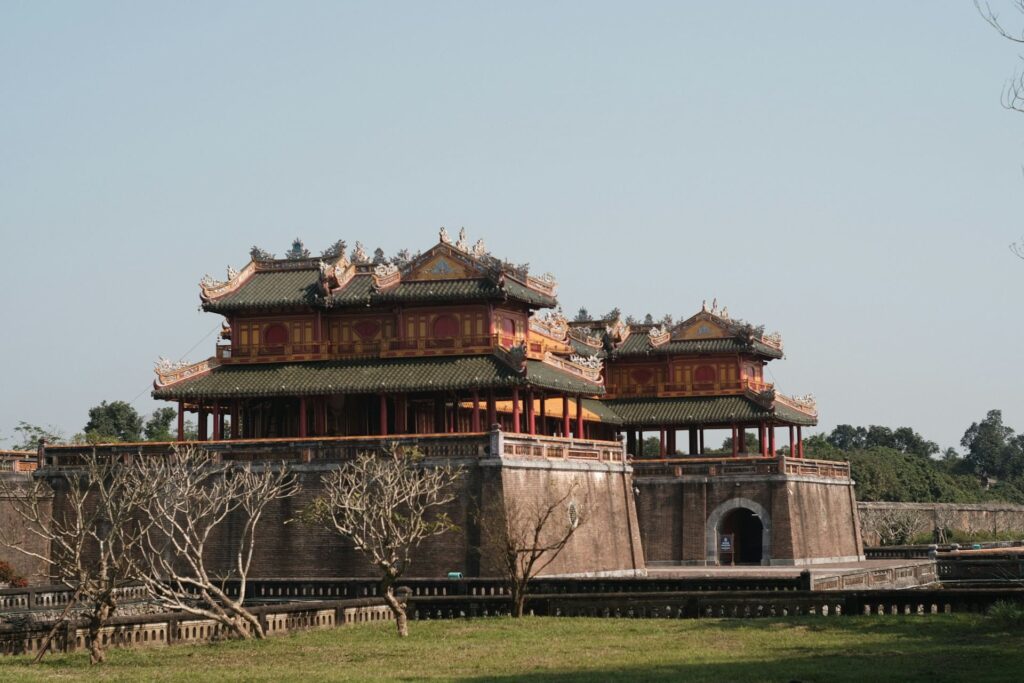
Hue (pronounced “hway”), Vietnam’s capital from 1802 to 1945 under the Nguyen Dynasty, preserves the country’s most impressive imperial heritage. This UNESCO World Heritage City, designated in 1993, sits along the Perfume River (Song Huong) in central Vietnam, offering a contemplative counterpoint to bustling Hanoi and Ho Chi Minh City.
Highlights
The Imperial City (Dai Noi), a walled fortress and palace complex modeled after Beijing’s Forbidden City, sprawls across 520 hectares. While American bombing during the Vietnam War destroyed many structures, ongoing restoration reveals the grandeur of imperial Vietnam. Key sites include the Thai Hoa Palace, the Forbidden Purple City, and the Nine Dynastic Urns.
Thien Mu Pagoda (Pagoda of the Celestial Lady), built in 1601, stands as Hue’s most iconic religious structure. Its seven-tiered octagonal tower overlooks the Perfume River, creating one of Vietnam’s most photographed scenes. The pagoda houses the Austin car driven by monk Thich Quang Duc to Saigon in 1963 for his self-immolation protest—a pivotal moment in Vietnamese history.
The Royal Tombs scattered along the Perfume River showcase unique architectural visions of Vietnam’s last emperors. Tomb of Khai Dinh (1920-1931) blends Vietnamese and European styles with elaborate mosaics. Tomb of Minh Mang (1840-1843) emphasizes harmony with nature across its 18-hectare complex. Tomb of Tu Duc (1864-1867), the most popular, features a lake, pavilions, and a theater.
The Dong Ba Market, Hue’s largest traditional market, offers authentic local life—far from tourist zones—with regional specialties, conical hats (non la), and vibrant produce.
Why Visit
Hue represents the soul of Vietnamese imperial culture and royal traditions. The city’s distinctive cuisine ranks among Vietnam’s finest—bun bo Hue (spicy beef noodle soup) originated here, while royal cuisine (com nieu) traditions continue in specialty restaurants serving elaborate multi-course meals historically prepared for emperors.
The city’s contemplative atmosphere appeals to travelers seeking cultural depth over beach parties or shopping. According to UNESCO, Hue’s Complex of Monuments represents “an outstanding demonstration of the power of the Nguyen dynasty.”
Hue also serves as an excellent base for exploring the DMZ (Demilitarized Zone)—a sobering reminder of the Vietnam War’s impact, located just 60km north.
Best Time to Visit
January through April provides the driest, most pleasant weather (temperatures 20-25°C). March and April offer particularly beautiful conditions for photographing imperial sites.
Avoid October through December, Hue’s wettest season, when the Perfume River often floods. The city receives over 3,000mm of rain annually—among Vietnam’s highest rainfall levels—with 70% falling from September to December.
How to Get There
Phu Bai International Airport (HUI), 15km south of the city, offers direct flights from Hanoi, Ho Chi Minh City, and Da Nang (~$40-80).
The Reunification Express train connects Nha Trang to Hanoi (28 hours) and Ho Chi Minh City (8 hours), with comfortable sleeper options available.
Multiple bus companies operate routes throughout Vietnam, with overnight sleeper buses to HCMC and Da Nang being popular choices.
6. Da Nang
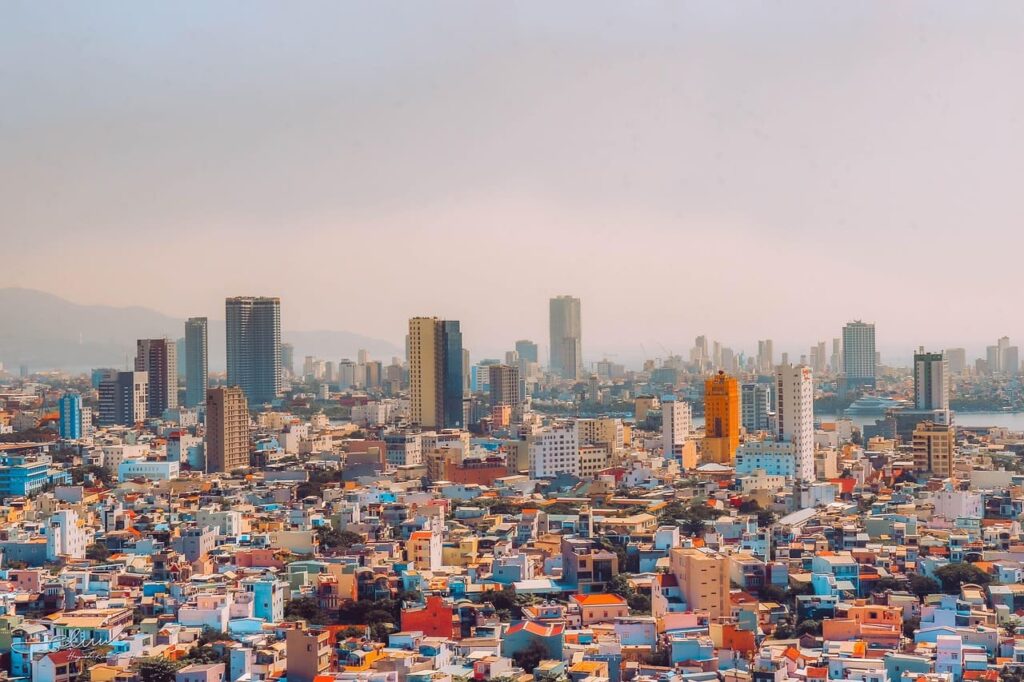
Da Nang, Vietnam’s third-largest city, has transformed from a sleepy coastal town into a modern, dynamic destination that successfully balances urban sophistication with natural beauty. With a population exceeding 1.2 million, Da Nang serves as central Vietnam’s economic and tourism hub while maintaining surprisingly clean, organized streets compared to other Vietnamese cities.
Highlights
My Khe Beach, famously praised as one of the world’s most beautiful beaches by Forbes, stretches for 30 kilometers of pristine white sand. Less crowded than Thailand’s famous beaches, My Khe offers excellent swimming, surfing, and spectacular sunrises. The beach was nicknamed “China Beach” by American soldiers during the Vietnam War.
The Marble Mountains (Ngu Hanh Son), five limestone and marble hills named after five elements (metal, wood, water, fire, earth), contain Buddhist sanctuaries, cave pagodas, and spectacular views. Explore Huyen Khong Cave, Am Phu Cave (representing heaven and hell), and climb to viewpoints overlooking Da Nang and the coastline.
The Golden Bridge (Cau Vang), opened in 2018, became an instant Instagram sensation. Two giant concrete hands appear to cradle this 150-meter pedestrian bridge at 1,400 meters elevation in the Ba Na Hills. The surreal structure offers breathtaking mountain vistas and has won multiple architectural awards.
Ba Na Hills, a French colonial hill station turned theme park, features cable cars holding Guinness World Records for longest single track and highest altitude difference (1,368m). While touristy, the complex offers cool mountain air, French gardens, and the Golden Bridge experience.
The Dragon Bridge (Cau Rong), a 666-meter modern marvel, breathes fire and water every weekend evening at 9 PM (a spectacular free show drawing crowds to the riverside).
Why Visit
Da Nang excels as a comfortable base for exploring central Vietnam’s highlights. Hoi An (30km south), Hue (100km north), and My Son (40km southwest) are all easy day trips. The city itself combines modern amenities (international hotels, excellent restaurants, clean beaches) with Vietnamese culture.
The city’s culinary scene shines, with mi Quang (turmeric noodles with shrimp and pork) being the local specialty. The Han Market and nearby street food stalls offer authentic experiences, while the riverside hosts upscale international dining.
According to World Travel Awards, Da Nang has won “Asia’s Leading Festival and Event Destination” multiple times, hosting the International Fireworks Festival and various cultural events.
Best Time to Visit
February through May offers ideal beach weather: sunny, warm (25-30°C), and dry. March to April provides the perfect balance before summer heat intensifies.
June through August brings intense heat (up to 38°C) but remains popular with Vietnamese domestic tourists. September through January sees more rain and occasional typhoons, particularly September-November.
How to Get There
Da Nang International Airport (DAD), Vietnam’s third-busiest, offers excellent domestic and international connections. Located just 3km from the city center, it’s easily accessible via taxi (approximately 100,000 VND, $4-5) or Grab.
The Reunification Express train connects Da Nang to Hanoi (14 hours) and Ho Chi Minh City (17 hours), with the Da Nang-Hue section being particularly scenic.
Numerous bus companies operate routes connecting Da Nang throughout Vietnam, with sleeper buses making overnight journeys to Hanoi and HCMC comfortable.
Travel tip: Use Top Travel Insider to book combined Da Nang and Hoi An accommodations for the best deals on Central Vietnam exploration.
7. Hoi An
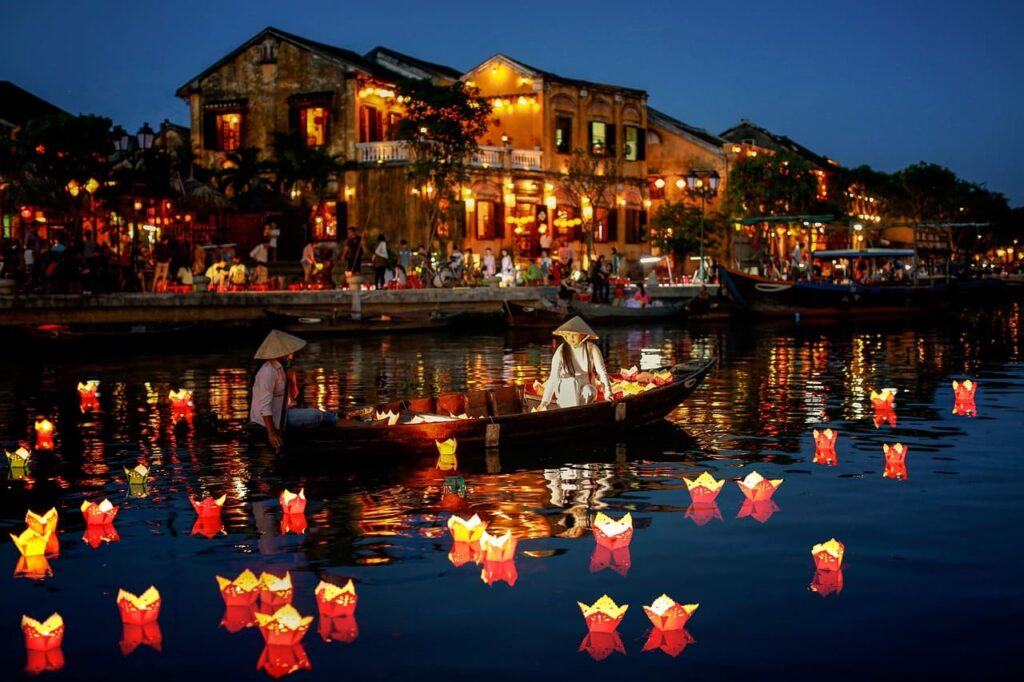
Hoi An, a UNESCO World Heritage Site since 1999, represents one of Asia’s best-preserved trading ports. This enchanting town of 152,000 residents freezes time in its Ancient Town, where Japanese, Chinese, French, and Vietnamese influences blend into architectural harmony. Nicknamed “The Venice of Vietnam,” Hoi An’s lantern-lit canals and car-free streets create pure magic, especially on full moon nights.
Highlights
The Ancient Town (Pho Co Hoi An) restricts vehicles, creating a pedestrian paradise. Highlights include:
The Japanese Covered Bridge (Chua Cau), built in 1593, symbolizes Hoi An and appears on Vietnam’s 20,000 dong note. This iconic structure features a temple inside and connects the Japanese and Chinese quarters.
Tan Ky Old House (1741), a perfectly preserved merchant house showcasing architectural fusion (Japanese beams, Chinese furniture, Vietnamese decorative elements) represents the town’s multicultural heritage.
Assembly Halls (Hoi Quan), particularly the Fujian Assembly Hall with its intricate dragon fountains and the Cantonese Assembly Hall, demonstrate the Chinese community’s influence on Hoi An’s development.
The Thu Bon River comes alive during the monthly Full Moon Lantern Festival (Nguyen Tieu), when electric lights are extinguished and thousands of silk lanterns illuminate streets and float down the river. Traditional games, music, and performances transport visitors to ancient times.
Tailor shops line every street. Hoi An’s famous custom clothing industry can create suits, dresses, or leather goods within 24 hours at reasonable prices. While quality varies, reputable shops produce excellent results.
An Bang Beach and Cua Dai Beach, just 4-5km from town, offer peaceful seaside relaxation with beach clubs, fresh seafood, and fewer crowds than Da Nang’s beaches.
Why Visit
Hoi An delivers Vietnam’s most atmospheric experience. The town successfully balances heritage preservation with tourism development. The Ancient Town remains largely unchanged, while newer areas accommodate hotels and services.
The town’s culinary scene excels, with specialties like cao lau (thick noodles with pork, found only in Hoi An), white rose dumplings (banh bao banh vac), and banh mi that rivals Hanoi’s versions. The Hoi An Cooking School and similar establishments offer market tours and hands-on classes.
According to UNESCO, Hoi An’s Ancient Town represents “an exceptionally well-preserved example of a South-East Asian trading port dating from the 15th to the 19th century.”
The town’s cycling culture makes exploration easy. Rent bicycles to tour surrounding villages, rice paddies, and workshops producing traditional crafts (lanterns, pottery, carpentry).
Best Time to Visit
February through April offers optimal conditions with dry weather, comfortable temperatures (22-28°C), and colorful Tet celebrations if visiting in late January/early February.
August through October provides another good window, though occasional rain is possible. September’s Full Moon Lantern Festival is particularly spectacular.
Avoid October through January when heavy rains and occasional flooding disrupt activities. The Ancient Town sometimes experiences ankle-deep water during this period.
How to Get There
Hoi An lacks an airport, so most visitors arrive via Da Nang International Airport (30km away):
- Taxi: approximately 400,000 VND ($16-20) for the 45-minute journey
- Grab: Similar pricing, more transparent
- Shuttle bus: Many hotels offer airport pickups (approximately $10-15 per person)
- Motorcycle taxi (xe om): Adventurous option for solo travelers
From Da Nang or Hue, numerous bus companies operate affordable routes (1 hour from Da Nang, approximately $2-5).
Many travelers combine Da Nang (for beaches and airport access) with Hoi An (for ancient town charm) in their itinerary.
8. Nha Trang
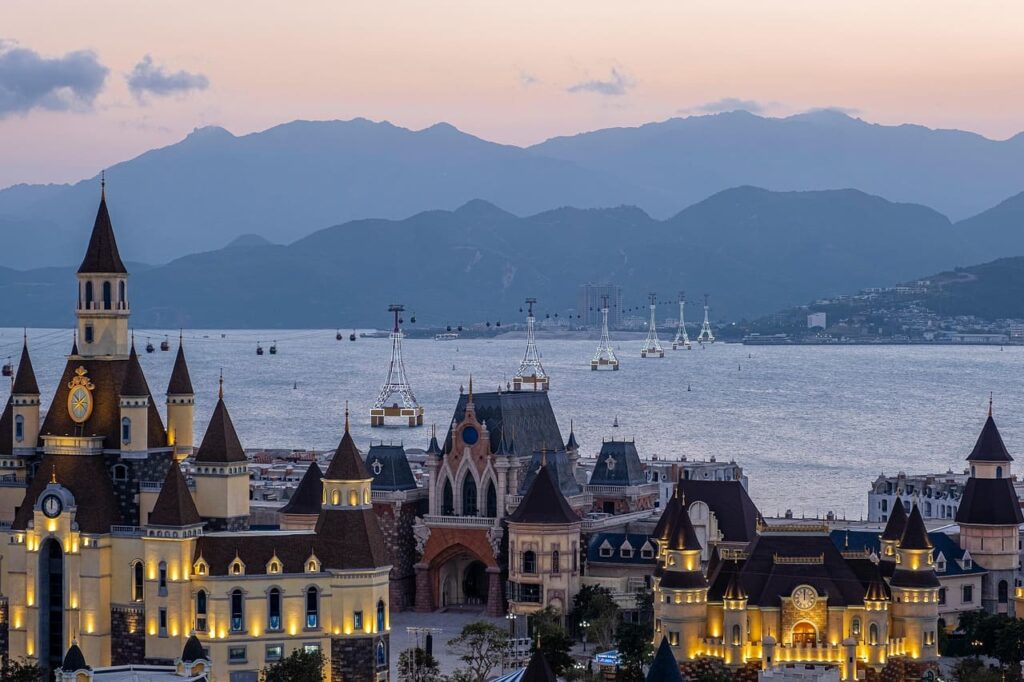
Nha Trang, Vietnam’s premier beach city, offers a different vibe from the country’s cultural heartlands. This vibrant coastal metropolis of 500,000 people caters to those seeking sun, sand, and water sports, with a lively nightlife scene and excellent seafood. Often called “The Riviera of the South China Sea,” Nha Trang successfully balances mass tourism with authentic Vietnamese coastal culture.
Highlights
Nha Trang Beach, a 6-kilometer crescent of golden sand, fronts a picturesque bay dotted with islands. The municipal beach features a beautiful promenade, beachfront bars, and water sports ranging from jet-skiing to parasailing. While developed, it maintains cleanliness standards exceeding most Southeast Asian beach destinations.
Vinpearl Land, accessed via a spectacular 3,320-meter cable car (one of the world’s longest over-sea cable cars), occupies Hon Tre Island. This resort complex combines a water park, amusement park, aquarium, and luxury accommodations. Popular with families and Vietnamese domestic tourists.
Po Nagar Cham Towers, built between the 7th-12th centuries, represent the ancient Champa Kingdom’s Hindu-Buddhist culture. These brick temples, still active worship sites, offer historical depth and panoramic city views from their hilltop location.
Hon Mun Island, part of a marine protected area, ranks among Vietnam’s best diving and snorkeling destinations. Crystal-clear waters reveal vibrant coral gardens supporting over 350 coral species and countless tropical fish. Multiple dive shops offer PADI certifications and guided dives.
Long Son Pagoda, featuring a 24-meter white Buddha statue visible throughout the city, provides cultural context and sunset views. The dragon mosaic staircase leading to the Buddha makes for striking photographs.
Mud baths at I-Resort or Thap Ba represent a uniquely Vietnamese spa experience. Luxuriate in mineral-rich volcanic mud believed to have therapeutic properties, followed by hot springs soaking.
Why Visit
Nha Trang excels as Vietnam’s water activities capital. Scuba diving, snorkeling, island hopping, and sailing dominate daily activities. The city’s tourism infrastructure (from budget hostels to five-star resorts) accommodates all budgets.
The nightlife scene, particularly around the backpacker area and Sailing Club, rivals Pattaya or Phuket with beach clubs, rooftop bars, and live music venues. This makes Nha Trang popular with younger travelers and party-seekers.
Seafood reaches peak freshness and affordability. Massive grilled prawns, grilled oysters, and seafood hot pots at beachside restaurants cost a fraction of Western prices. Dam Market offers local seafood shopping experiences.
According to Vietnam Tourism statistics, Nha Trang welcomes over 7 million visitors annually, with strong Russian, Chinese, and Korean tourist presence contributing to its international atmosphere.
Best Time to Visit
January through August offers the longest dry season. Peak conditions from February to May with calm seas, sunshine, and temperatures around 26-28°C.
September through December brings monsoons, rough seas, and occasional coastal flooding. Many water activities close during this period, making visits less appealing.
How to Get There
Cam Ranh International Airport (CXR), 35km south of Nha Trang, handles domestic and international flights (particularly from Russia, China, and Korea). Airport transfers include:
- Airport shuttle: approximately 100,000 VND ($4-5)
- Taxi/Grab: approximately 300,000-400,000 VND ($12-16)
- Private transfer: Pre-booked through hotels
The Reunification Express train connects Nha Trang to Hanoi (28 hours) and Ho Chi Minh City (8 hours), with comfortable sleeper options available.
Multiple bus companies operate routes throughout Vietnam, with overnight sleeper buses to HCMC and Da Nang being popular choices.
9. Da Lat
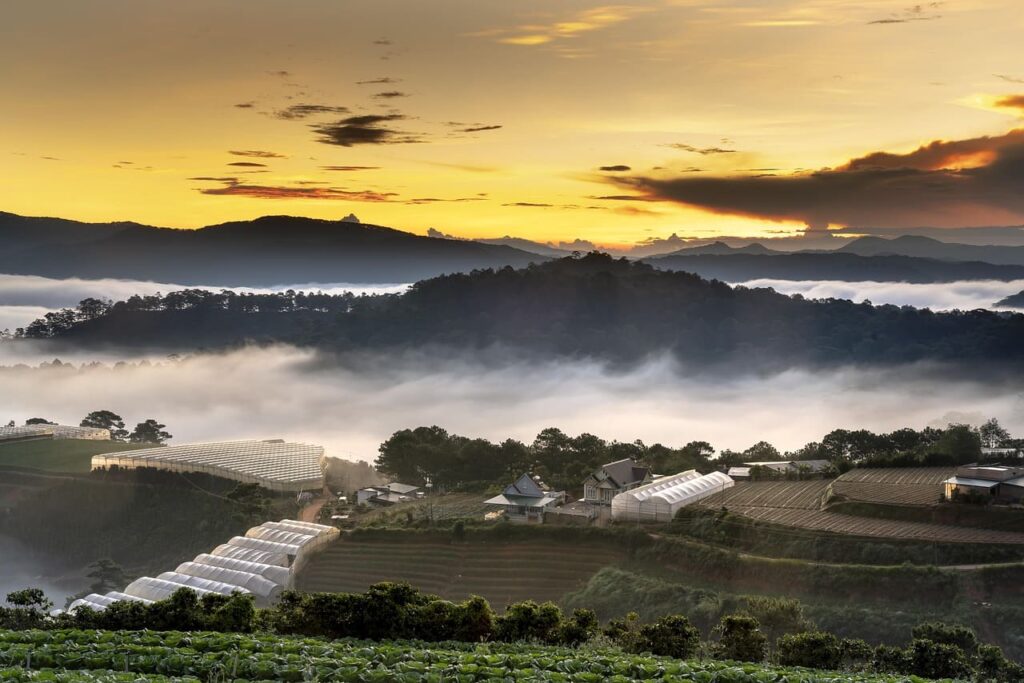
Da Lat, perched at 1,500 meters elevation in Vietnam’s Central Highlands, offers a refreshing escape from tropical heat. This mountain resort town of 400,000 people maintains year-round spring-like temperatures (15-24°C), earning its nickname “The City of Eternal Spring.” French colonials developed Da Lat in the 1890s as a summer retreat, leaving behind distinctive architecture, pine forests, and a romantic European atmosphere.
Highlights
Xuan Huong Lake, a crescent-shaped artificial lake at the city center, provides the perfect introduction to Da Lat’s charm. Rent swan paddle boats, cycle the 7km perimeter path, or simply enjoy lakeside cafés with mountain views.
Datanla Falls, 5km from the city center, offers adventure activities including a thrilling alpine coaster that winds through forest to the waterfall base. The falls themselves cascade through multiple tiers, creating natural pools for swimming.
Crazy House (Hang Nga Guesthouse), designed by architect Dang Viet Nga, defies architectural conventions with its Gaudí-inspired organic design featuring cave-like rooms, spiral staircases, and sculptural elements resembling trees and animals. This bizarre yet fascinating attraction functions as both a guesthouse and popular tourist site.
Truc Lam Monastery, a serene Zen Buddhist monastery reached via cable car over Tuyen Lam Lake, offers spiritual tranquility amidst pine forests. The monastery complex, established in 1993, welcomes visitors for meditation sessions.
Da Lat Flower Gardens and countless flower farms showcase the region’s horticultural prowess—roses, hydrangeas, and ornamental plants thrive in the cool climate. The city supplies flowers throughout Vietnam, with flower cultivation being a major industry.
Langbiang Mountain, the region’s highest peak (2,169m), offers hiking opportunities and panoramic views. Reach the summit via jeep or on foot for sunrise/sunset experiences.
Da Lat Night Market and Da Lat Market (Cho Da Lat) provide authentic local experiences—sample banh trang nuong (Vietnamese pizza), grilled corn, and strawberry products. The markets overflow with fresh produce, dried fruits, and artichoke tea (a Da Lat specialty).
Why Visit
Da Lat represents Vietnam’s romantic getaway destination, beloved by Vietnamese honeymooners and domestic tourists. The city’s unique microclimate allows cultivation of strawberries, artichokes, coffee, and temperate vegetables impossible elsewhere in Vietnam.
The surrounding coffee plantations produce some of Vietnam’s finest arabica beans (most of Vietnam grows robusta). Coffee tours and tastings at farms like K’ho Coffee and La Viet Coffee reveal Vietnam’s emerging specialty coffee scene.
Da Lat’s French colonial architecture—pastel villas, railway station, and churches—creates unexpectedly European ambiance. The Da Lat Railway Station, with its distinctive art deco design, offers short scenic train rides to Trai Mat village.
According to local tourism data, Da Lat welcomes over 8 million visitors annually, with numbers steadily increasing as Vietnamese middle-class tourism grows.
Best Time to Visit
November through March offers the driest weather and coolest temperatures (12-20°C)—bring layers as evenings can be genuinely chilly. December and January may require light jackets.
April through October brings more rain, particularly afternoon showers, but the landscape becomes lush and green. Flower blooms peak during this period, creating spectacular displays.
Da Lat’s consistent mild climate makes it viable year-round, unlike beach destinations with monsoon seasons.
How to Get There
Lien Khuong Airport (DLI), 30km south of Da Lat, offers daily flights from Hanoi and Ho Chi Minh City (~$40-80). Airport transfers include:
- Airport shuttle: ~100,000 VND ($4)
- Taxi: ~250,000-300,000 VND ($10-12)
Bus from Ho Chi Minh City is the most popular overland option (6-7 hours, ~$8-12). Companies like Phuong Trang and Hanh Café operate comfortable sleeper buses through scenic mountain roads.
Private car from HCMC offers flexibility for stops at coffee plantations and viewpoints along the route (~$80-120).
The winding mountain roads to Da Lat rank among Vietnam’s most scenic drives, passing through Di Linh Pass with breathtaking valley views.
10. Ho Chi Minh City
Ho Chi Minh City (HCMC, still commonly called Saigon), Vietnam’s largest city with 13 million people in the metropolitan area, pulses with relentless energy. This economic powerhouse generates approximately 23% of Vietnam’s GDP according to World Bank data, embodying modern Vietnam’s entrepreneurial spirit while preserving its complex history.
Highlights
Ben Thanh Market, the city’s most famous market since 1914, operates as both tourist attraction and local shopping hub. While touristy during the day, the surrounding night market offers authentic street food experiences. Navigate stalls selling everything from ao dai (traditional dresses) to spices, coffee, and handicrafts.
Notre Dame Cathedral (Nha Tho Duc Ba), built between 1863-1880 with materials imported from France, stands as a pink-brick colonial landmark. Though closed for renovation until 2027, the exterior remains impressively photogenic against the modern skyline.
War Remnants Museum provides sobering, emotional documentation of the Vietnam War (called the American War in Vietnam) from the Vietnamese perspective. Exhibits include military equipment, photographs, and Agent Orange impacts—challenging but essential for understanding modern Vietnamese history.
Cu Chi Tunnels, 70km northwest of the city, reveal the underground network where Viet Cong guerrillas lived and fought during the war. Crawl through enlarged sections of the 250km tunnel system and experience firsthand the harsh conditions. Half-day and full-day tours operate daily.
Reunification Palace (Dinh Độc Lập), site of the Fall of Saigon on April 30, 1975 when North Vietnamese tanks crashed through its gates, preserves 1960s architecture and the telecommunications room where surrender was announced.
Bitexco Financial Tower, HCMC’s tallest building (262m), features the Saigon Skydeck on the 49th floor offering 360-degree city views. The helicopter pad design makes the building instantly recognizable in the skyline.
District 1 contains the colonial quarter, luxury shopping, and international dining, while District 2 (Thu Thiem) represents the city’s future with modern developments. District 3 offers authentic local neighborhoods away from tourist crowds.
Bui Vien Street, the backpacker district, buzzes with bars, hostels, and international restaurants—HCMC’s answer to Bangkok’s Khao San Road.
Why Visit
HCMC represents Vietnam’s economic engine and cosmopolitan face. The city’s food scene ranks among Asia’s best—from street food stalls serving banh xeo (sizzling pancakes) and hu tieu (southern noodle soup) to Michelin-recognized restaurants like The Racha Room.
The shopping ranges from sprawling Saigon Square malls and Vincom Center to Dong Khoi Street’s luxury boutiques. Nguyen Hue Walking Street, a pedestrianized boulevard, hosts events and provides car-free people-watching opportunities.
Nightlife thrives across rooftop bars (Social Club, Saigon Saigon Bar), live music venues, and nightclubs. The city truly never sleeps—street food vendors operate 24/7.
HCMC serves as the gateway to the Mekong Delta—day trips to floating markets, fruit orchards, and traditional villages depart daily, offering insights into southern Vietnamese rural life.
According to tourism statistics, HCMC targets 35 million visitors in 2024, with international arrivals rebounding strongly post-pandemic.
Why Visit
HCMC delivers Vietnam at maximum velocity—motorbike chaos, street food on every corner, and business deals happening in sidewalk cafés. The French colonial quarter, especially around Dong Khoi Street, preserves elegant architecture including the Opera House (Municipal Theater) and historic hotels.
The city’s complexity and contradictions fascinate—luxury shopping malls overlook street food vendors, while centuries-old pagodas sit beside modern skyscrapers. This juxtaposition defines contemporary Vietnam.
Best Time to Visit
December through April offers the dry season with pleasant temperatures (25-32°C) and minimal rain—peak tourist season with higher prices but optimal conditions.
May through November brings the wet season with heavy afternoon downpours, high humidity, and occasional flooding. However, this period sees fewer tourists and better hotel deals. Rain typically arrives predictably in late afternoon, rarely disrupting morning activities.
How to Get There
Tan Son Nhat International Airport (SGN), Vietnam’s busiest airport, handled over 38 million passengers in 2023. Located just 8km from District 1, it’s easily accessible:
- Taxi: ~150,000-200,000 VND ($6-8) to city center
- Grab: Similar pricing with transparent meters
- Airport bus: Route 109 to Ben Thanh Market (~40,000 VND, $1.50)
HCMC serves as the southern terminus of the Reunification Express train from Hanoi (30-35 hours), with stops at all major cities.
Numerous bus companies connect HCMC to destinations throughout southern Vietnam and beyond to Cambodia (Phnom Penh buses depart daily).
Insider tip: Book your HCMC hotels and experiences through Top Travel Insider to navigate the city’s overwhelming options and secure prime locations in District 1.
Practical Travel Table
| Destination | Region | Best Time | Main Highlights | Nearest Airport | Approx. Daily Budget* |
|---|---|---|---|---|---|
| Hanoi | North | Oct–Apr | Old Quarter, Hoan Kiem Lake, Temple of Literature | Noi Bai Intl. (HAN) | $30-50 |
| Ha Long Bay | North | Mar–Jun, Sep–Nov | Cruise tours, Karsts, Caves | Hanoi (transfer) | $60-150 (incl. cruise) |
| Sapa | North | Mar–May, Sep–Nov | Rice Terraces, Fansipan, Hill Tribes | Hanoi (train/bus) | $25-40 |
| Ninh Binh | North | Feb–May, Sep–Oct | Trang An, Tam Coc, Temples | Hanoi (transfer) | $20-35 |
| Hue | Central | Jan–Apr | Imperial City, Tombs, Pagodas | Phu Bai (HUI) | $25-45 |
| Da Nang | Central | Feb–May | My Khe Beach, Golden Bridge, Marble Mountains | Da Nang Intl. (DAD) | $30-60 |
| Hoi An | Central | Feb–Apr, Aug–Oct | Ancient Town, Lanterns, Tailors | Da Nang Intl. (DAD) | $25-50 |
| Nha Trang | South-Central | Jan–Aug | Beaches, Islands, Diving, Vinpearl | Cam Ranh (CXR) | $25-50 |
| Da Lat | Highlands | Nov–Mar | Waterfalls, Lakes, Coffee, Flowers | Lien Khuong (DLI) | $20-40 |
| Ho Chi Minh City | South | Dec–Apr | Markets, War Sites, Cu Chi Tunnels | Tan Son Nhat (SGN) | $30-60 |
Daily budgets include accommodation, food, local transport, and attractions for budget-conscious travelers. Luxury travelers should expect 3-5x these amounts.
Cultural Insights
Vietnamese Hospitality and Social Customs
Vietnamese people rank among Asia’s friendliest and most welcoming. The concept of hospitality (hiếu khách) runs deep—expect genuine interest in your travels and origins. However, several cultural norms deserve respect:
Greetings: A slight bow or nod with hands pressed together (similar to Thai wai but less common) shows respect to elders. Handshakes work for business contexts.
Temple etiquette: Remove shoes before entering temples and homes. Dress modestly (cover shoulders and knees). Ask permission before photographing people at worship.
Personal space: Physical affection between couples draws disapproval in rural areas, while same-sex friends commonly hold hands platonically.
Vietnamese Cuisine Beyond Pho
While pho (noodle soup) achieves global fame, Vietnamese cuisine offers extraordinary regional diversity:
Northern cuisine (Hanoi) emphasizes subtle flavors: bun cha (grilled pork with noodles), cha ca (turmeric fish), banh cuon (steamed rice rolls).
Central cuisine (Hue) features spicier, more elaborate dishes reflecting imperial traditions: bun bo Hue (spicy beef noodle soup), banh beo (water fern cakes), nem lui (lemongrass skewers).
Southern cuisine (HCMC) uses more sugar and coconut: banh xeo (crispy pancakes), hu tieu (pork noodle soup), ca kho to (caramelized fish in clay pot).
Coffee culture dominates Vietnamese social life. Vietnam ranks as the world’s second-largest coffee exporter after Brazil. Try ca phe sua da (iced coffee with condensed milk), ca phe trung (egg coffee from Hanoi), or ca phe cot dua (coconut coffee from Hue).
Banh mi, the Vietnamese baguette sandwich, combines French colonial influence with Vietnamese flavors—pâté, pickled vegetables, cilantro, and various proteins create perfect street food.
Festivals and Celebrations
Tet Nguyen Dan (Lunar New Year), typically January-February, represents Vietnam’s most important celebration. Cities empty as people return to ancestral homes. While atmospheric, many businesses close for 3-7 days—plan accordingly.
Mid-Autumn Festival (Tet Trung Thu), the children’s festival in September-October, features mooncakes, lantern parades, and lion dances.
Perfume Pagoda Festival (January-March, Hanoi) draws thousands of Buddhist pilgrims for spiritual blessings.
Hoi An Lantern Festival occurs monthly on the 14th day of each lunar month, when the ancient town extinguishes electric lights in favor of traditional lanterns.
Sustainable Travel Practices
Vietnam faces environmental challenges from rapid tourism growth. Responsible travelers can help by:
Reducing plastic: Bring reusable water bottles (tap water isn’t potable, but refill stations are increasingly common), refuse plastic bags and straws.
Supporting local businesses: Choose locally-owned hotels, restaurants, and tour operators. Purchase handicrafts directly from artisans.
Respecting wildlife: Avoid attractions featuring animal exploitation (elephant rides, bear bile farms, civet coffee unless verified ethical).
Cultural sensitivity: Many hill tribe communities in Sapa and the Central Highlands suffer from “human zoo” tourism. Choose homestays that genuinely benefit local families over staged photo opportunities.
Coral protection: When snorkeling or diving (especially Nha Trang, Con Dao), never touch coral, maintain proper buoyancy, and use reef-safe sunscreen.
According to Vietnam’s National Administration of Tourism, sustainable tourism initiatives aim to balance growth with preservation—travelers’ choices significantly impact these efforts.
Conclusion – Top 10 Places to visit in Vietnam
Vietnam’s top 10 destinations showcase a nation of remarkable diversity—from Hanoi’s thousand-year-old streets to Ho Chi Minh City’s modern skyline, from Ha Long Bay’s ethereal seascape to Sapa’s terraced mountains. Each destination contributes unique threads to Vietnam’s rich cultural tapestry.
For culture enthusiasts, Hanoi, Hue, and Hoi An deliver deep historical immersion. Beach lovers will find paradise in Da Nang and Nha Trang. Adventure seekers should prioritize Sapa’s treks and Ha Long Bay’s cruises. Romantic travelers will fall for Da Lat’s European atmosphere and Hoi An’s lantern-lit evenings.
The beauty of Vietnamese travel lies in its accessibility and affordability. An extensive domestic flight network connects major cities in under 2 hours, while trains offer scenic overland alternatives. Budget travelers can explore comfortably on $30-40 daily, while $100 daily unlocks luxury experiences.
Beyond these top 10, Vietnam offers countless hidden gems: the pristine beaches of Phu Quoc Island, the ethnic diversity of Ha Giang Province, the wildlife sanctuary of Cat Tien National Park, and the emerging destinations of Quy Nhon and Phan Thiet. Each visit reveals new layers of this fascinating country.
As Vietnam continues modernizing while preserving its heritage, the next decade promises even more spectacular developments. Yet the soul remains unchanged—warm hospitality, incredible food, and landscapes that inspire poets and photographers alike.
Plan your Vietnamese adventure through comprehensive resources like Top Travel Insider to navigate logistics, discover insider tips, and create an unforgettable journey through these remarkable destinations. Whether you spend two weeks or two months, Vietnam’s magic ensures you’ll leave already planning your return.
Frequently Asked Questions
What is the best month to visit Vietnam?
March to April offers the most universally pleasant weather across the country. Northern Vietnam (Hanoi, Ha Long Bay, Sapa) enjoys warm, dry conditions, central Vietnam (Hue, Hoi An, Da Nang) sees minimal rain, and southern regions (HCMC, Mekong Delta) experience comfortable temperatures before the rainy season intensifies.
However, Vietnam’s 1,650km length creates distinct regional climates, so “best” depends on your itinerary:
- North Vietnam: October–April (cool, dry)
- Central Vietnam: February–May (avoid September–December’s heavy rains)
- South Vietnam: December–April (dry season)
February–April represents the optimal window for north-to-south journeys.
How many days do you need in Vietnam?
10-14 days allows a balanced exploration of Vietnam’s highlights:
- 7-day itinerary: Hanoi (2 days) → Ha Long Bay (1-2 days) → Hoi An (2 days) → Ho Chi Minh City (2 days)
- 10-day itinerary: Add Hue (2 days) and extend stays in key cities
- 14-day itinerary: Include Sapa (2-3 days), Ninh Binh (1-2 days), and Da Nang/Nha Trang
- 21+ days: Comprehensive coverage including Da Lat, Mekong Delta, Phu Quoc, and off-beaten-path destinations
Many travelers underestimate Vietnam’s size—rushing between destinations reduces enjoyment. Quality trumps quantity.
Is Vietnam expensive for travelers?
No, Vietnam ranks among Southeast Asia’s most affordable destinations. Budget estimates (2024 prices):
Budget travelers: $25-40/day
- Hostel bed: $5-10
- Street food meals: $2-5
- Local transport: $1-5
- Attractions: $2-10
Mid-range travelers: $50-100/day
- Comfortable hotel: $20-40
- Restaurant meals: $5-15
- Private transport/tours: $20-40
- Activities: $10-30
Luxury travelers: $150-300+/day
- Upscale hotels: $80-200+
- Fine dining: $30-100+
- Private tours/guides: $100-200
- Spa treatments, premium activities
Major cities (Hanoi, HCMC) and tourist hotspots (Hoi An, Ha Long Bay) cost more than secondary destinations. Vietnam remains significantly cheaper than Thailand’s tourist areas or any Western country.
Do I need a visa for Vietnam?
Visa requirements depend on nationality and length of stay. As of 2024:
Visa exemptions (no visa required for specified periods):
- 15 days: Germany, France, UK, Italy, Spain (and most EU countries)
- 30 days: Philippines, Thailand, Malaysia, Singapore, Indonesia
- 45 days: Belarus, Russia
- 90 days: Chile, Panama
The Vietnam Immigration Department maintains updated requirements.
E-visa available for 90 days, single or multiple entry, for citizens of all countries (as of August 2023). Apply online 3-7 days before travel ($25 fee).
Visa on arrival no longer officially operates—use e-visa instead.
Always verify current requirements before travel, as policies change frequently. Check your passport validity (6+ months remaining) and blank pages (2+ required).
Is Vietnam safe for solo travelers?
Yes, Vietnam is one of Southeast Asia’s safest destinations. Global Peace Index 2023 ranks Vietnam safer than the United States and most European countries regarding violent crime.
Safety considerations:
✅ Low violent crime: Physical attacks on tourists are extremely rare
✅ Women travelers: Vietnam is particularly safe for solo female travelers; harassment occurs less frequently than in India, Egypt, or Morocco
✅ Friendly locals: Vietnamese hospitality means solo travelers easily find help and conversation
⚠️ Petty theft: Snatch-and-grab bag theft from motorbikes occurs in HCMC and Hanoi—keep phones and valuables secured
⚠️ Scams: Taxi scams (use Grab or Mai Linh/Vinasun taxis), restaurant bill padding, and tour operator overcharging exist—research reputable providers
⚠️ Traffic: Vietnam’s chaotic traffic poses the biggest risk—exercise extreme caution crossing streets; motorbike accidents injure many tourists
⚠️ Food safety: Stick to busy food stalls with high turnover; most travelers experience minor stomach issues adjusting to the cuisine
Solo travel advantages in Vietnam:
- Easy to meet other travelers in hostels and tour groups
- Excellent English in tourist areas
- Affordable single supplements
- Efficient public transport and domestic flights
For comprehensive safety tips and recommended tour operators, resources like Top Travel Insider provide updated guidance specifically for Vietnam travelers.
Ready to explore Vietnam’s treasures? These top 10 destinations offer just the beginning of Vietnamese discovery. From ancient imperial cities to contemporary coastal resorts, from misty mountain valleys to bustling urban jungles, Vietnam delivers experiences that linger long after departure. Start planning your adventure today—Vietnam awaits with open arms, incredible food, and unforgettable memories.ification Express train** connecting Hanoi and Ho Chi Minh City stops at Hue, with particularly scenic sections between Da Nang and Hue crossing the Hai Van Pass—one of the world’s most spectacular coastal railway journeys.
From Da Nang:
- Train: 2.5-3 hours through stunning scenery (~$5-10)
- Bus: 3 hours (~$5-8)
- Private car: Most flexible (2.5 hours, ~$40-60)
